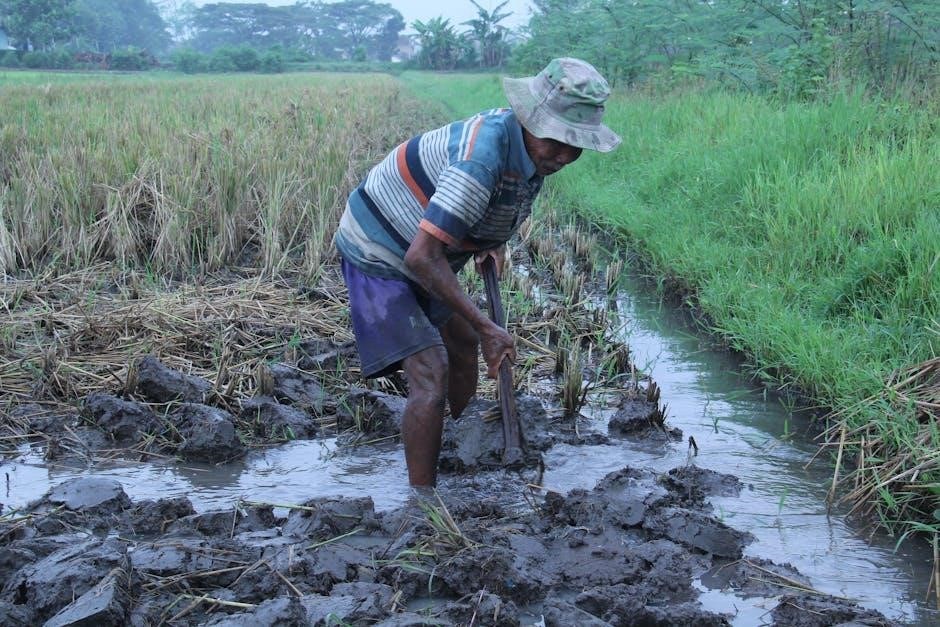Manual irrigation is a traditional method of watering plants and crops by hand, using tools like watering cans or buckets. It promotes water conservation and cost-effectiveness, making it ideal for small-scale gardening or areas without automated systems. This approach allows precise control over water distribution, ensuring plants receive the right amount of moisture. Manual irrigation is eco-friendly and enhances soil health, making it a sustainable choice for gardeners and farmers.
1.1 Definition and Purpose
Manual irrigation is a method where water is applied by hand, often using tools like watering cans or hoses. Its primary purpose is to provide plants with essential moisture when natural rainfall is insufficient. This approach offers precise control over water distribution, making it highly efficient and suitable for small-scale gardens or areas without automated irrigation systems. It supports healthy plant growth and effective soil moisture management, ensuring optimal water use.
1.2 Historical Context
Manual irrigation traces back to ancient civilizations, where people first used simple tools like buckets and canals to water crops. Early techniques were labor-intensive but effective, relying on rivers and rainfall. This method has been refined over centuries, with tools evolving to improve efficiency. Historically, manual irrigation was vital for agriculture in regions without advanced technologies, making it a cornerstone of farming practices worldwide.
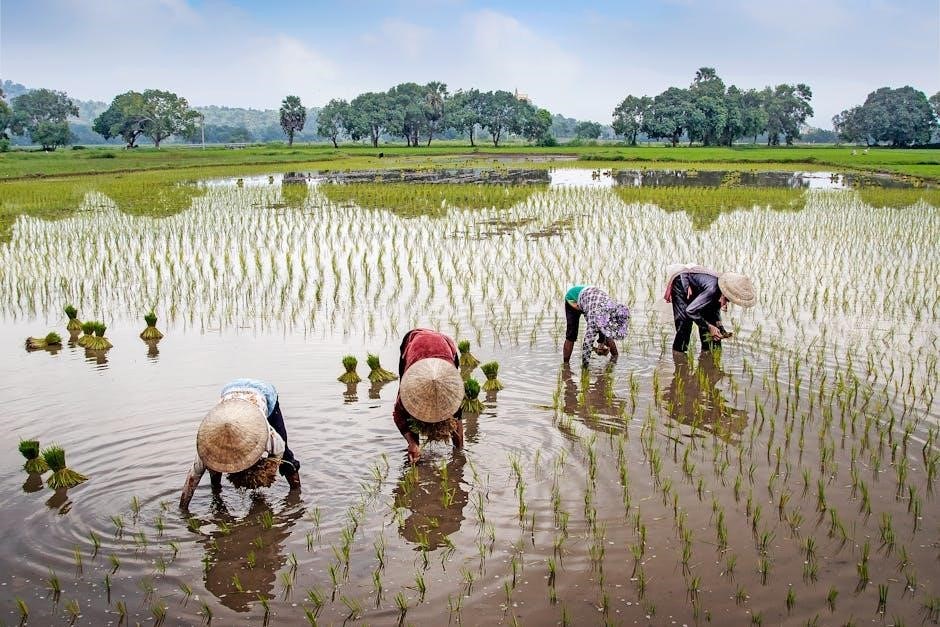
Methods of Manual Irrigation
Manual irrigation involves techniques like using watering cans, buckets, and hose pipes to deliver water directly to plants. These methods are simple, effective, and adaptable to various landscapes.
2.1 Watering Cans
Watering cans are a traditional and effective manual irrigation tool, ideal for small gardens. They allow precise water delivery to plants, reducing waste. Designed with a spout or rose, they enable gentle watering of delicate plants like seedlings. Portable and eco-friendly, watering cans are a cost-effective solution for targeted hydration, especially in areas with limited water access or for houseplants.
2.2 Buckets and Basins
Buckets and basins are simple, low-cost tools for manual irrigation, suitable for small-scale farming or home gardens. They allow water to be carried and poured directly onto plants or soil. Basins can also collect runoff for reuse, enhancing water efficiency. These methods are labor-intensive but effective, especially in regions with limited access to modern irrigation systems.
2.3 Hose Pipes
Hose pipes are versatile tools for manual irrigation, offering controlled water delivery. They are ideal for larger gardens or crops, allowing efficient coverage without frequent refilling. Hose pipes can be equipped with spray nozzles to customize water distribution, reducing waste and ensuring plants receive adequate moisture. This method balances efficiency and manual effort, making it popular among gardeners seeking flexibility.
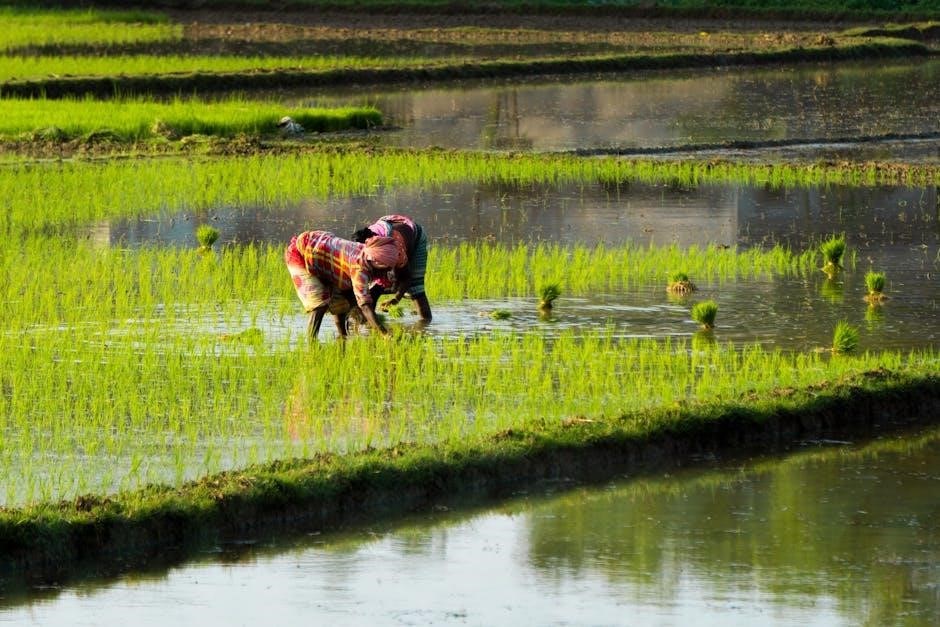
Tools and Equipment
Manual irrigation relies on simple, eco-friendly tools like watering cans, buckets, and hoses. These tools are cost-effective and easy to use, making them ideal for small-scale watering needs.
3.1 Watering Cans
Watering cans are essential tools for manual irrigation, designed for precise and controlled watering. They typically feature a handle, spout, and perforated rose for even water distribution; Available in various sizes, watering cans are ideal for small gardens or delicate plants, allowing targeted hydration without overwatering. Their portability and simplicity make them a popular choice for eco-friendly watering solutions.
3.2 Garden Hoses
Garden hoses are versatile tools for manual irrigation, offering efficient water distribution over larger areas. Made from durable materials like rubber or PVC, they are flexible and resistant to weather conditions. Adjustable nozzles allow for varied water pressure and spray patterns, making them ideal for different plant needs. Garden hoses are cost-effective and easy to use, promoting water conservation and healthy plant growth.
3.3 Sprinklers
Sprinklers are effective tools for manual irrigation, providing even water distribution across lawns or crops. They come in various types, such as fixed, rotating, or oscillating models, catering to different watering needs. Easy to install and operate, sprinklers save time and effort while ensuring consistent moisture delivery. Their versatility and efficiency make them a popular choice for both small and large-scale watering tasks.
Best Practices for Manual Irrigation
Adopt efficient watering techniques, monitor soil moisture, and irrigate during cooler parts of the day to minimize evaporation and ensure optimal water absorption by plants.
4.1 Watering Techniques
Efficient watering involves delivering water directly to roots, minimizing runoff. Techniques include deep watering for root strength, gentle sprinkling to avoid erosion, and mulching to retain moisture. Regular soil checks ensure optimal hydration without overwatering. Watering in the early morning or evening reduces evaporation, maximizing absorption and promoting healthy plant growth while conserving resources effectively.
4.2 Soil Moisture Management
Testing soil moisture levels is crucial to avoid overwatering. Proper drainage systems ensure water reaches plant roots without pooling. Incorporating organic matter improves soil structure, enhancing water retention. These practices prevent waterlogging and underwatering, support root health, and promote efficient water utilization in manual irrigation systems.
Benefits of Manual Irrigation
Manual irrigation offers cost-effectiveness, water conservation, and precise water control. It is ideal for small gardens, reduces waste, and promotes soil health, making it eco-friendly and efficient.
5.1 Water Conservation
Manual irrigation excels in water conservation by allowing precise control over distribution, reducing runoff and evaporation. It ensures plants receive the exact amount needed, minimizing waste. This method is particularly efficient in small-scale gardens or areas with limited water resources, promoting sustainable practices and eco-friendly gardening. It also reduces overall water consumption compared to automated systems.
5.2 Cost-Effectiveness
Manual irrigation is highly cost-effective, requiring minimal investment in equipment like watering cans or buckets. It eliminates the need for expensive automated systems, making it ideal for small gardens or budget-conscious gardeners. This method reduces long-term maintenance and energy costs, providing a practical and affordable solution for plant care without compromising efficiency or results.
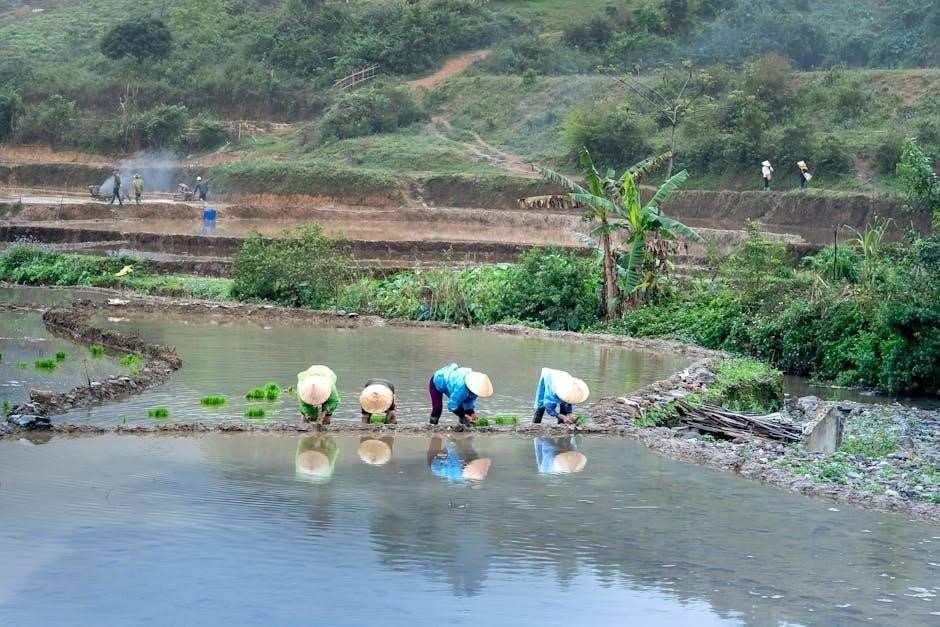
Challenges and Limitations
Manual irrigation requires significant labor and time, especially for large areas. It can be physically demanding and inefficient compared to automated systems, limiting its scalability.
6.1 Labor Intensity
Manual irrigation is highly labor-intensive, requiring significant physical effort and time. It involves repetitive tasks like watering plants individually, which can be tiring and time-consuming, especially for large areas. This method demands consistent human involvement, making it less efficient for extensive agricultural or gardening projects compared to automated systems.
6.2 Time Constraints
Manual irrigation is time-consuming, requiring frequent and consistent water application, especially for large areas or multiple plants. This method demands daily attention, making it challenging for individuals with limited time or managing multiple tasks. The repetitive nature of manual watering can delay other important activities, highlighting the need for efficient time management in irrigation schedules.
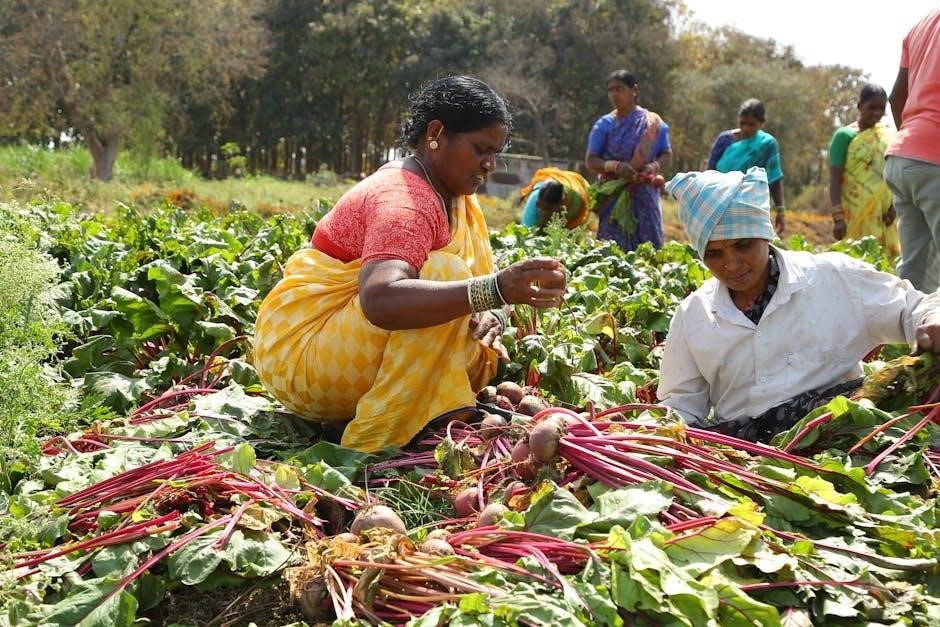
Innovations in Manual Irrigation
Innovations in manual irrigation include modern tools like adjustable nozzles and DIY systems, enhancing efficiency and sustainability. These advancements simplify watering processes while maintaining eco-friendly practices.
7.1 Modern Tools
Modern tools in manual irrigation include lightweight watering cans with long spouts, ergonomic handles, and adjustable nozzles. These designs reduce fatigue and improve water distribution. Innovations like micro-sprinklers and drip irrigation attachments further enhance efficiency, allowing precise watering control. Such tools are eco-friendly, reducing water waste while maintaining plant health. They are ideal for gardeners seeking sustainable and efficient solutions.
7.2 DIY Irrigation Systems
DIY irrigation systems offer cost-effective and customizable solutions for manual watering. Using materials like plastic bottles, hoses, and barrels, gardeners can create simple, eco-friendly setups. These systems allow precise water control and reduce waste. They are ideal for small gardens or areas with limited resources, promoting water conservation and sustainable gardening practices while being affordable and easy to assemble.
Environmental Impact
Manual irrigation promotes water conservation by reducing waste and targeting plant needs. It minimizes chemical runoff, protecting ecosystems and supporting sustainable agriculture practices and environmental health.
8.1 Water Efficiency
Manual irrigation enhances water efficiency by allowing precise control over water application, reducing evaporation and runoff. This targeted approach ensures plants receive adequate moisture without excess, aligning with sustainable practices and promoting healthy plant growth while conserving this vital resource.
8.2 Reduced Chemical Use
Manual irrigation promotes reduced chemical use by minimizing runoff and leaching, common in automated systems. Targeted watering ensures chemicals aren’t overused, fostering healthier plant growth and sustainable practices. This method reduces the risk of chemical contamination in soil and water, making it an eco-friendly choice for gardeners and farmers aiming to balance efficiency with environmental responsibility.
Manual irrigation is a practical, eco-friendly method offering precise water control and cost savings. Its simplicity ensures sustainability, making it a valuable technique for future agricultural practices.
9.1 Summary
Manual irrigation is a simple, effective method for watering plants and crops, emphasizing water conservation and cost-effectiveness. It offers precise control over water distribution, making it ideal for small-scale gardening and sustainable practices. By reducing reliance on automated systems, manual irrigation promotes eco-friendly farming and supports healthy plant growth, aligning with environmental goals and resource management.
9.2 Future Prospects
Manual irrigation is expected to evolve with innovative tools and sustainable practices, enhancing water efficiency and reducing labor intensity. Integration of smart technologies, like sensor-optimized watering cans, could improve precision and reduce waste. Community-driven systems and eco-friendly materials may also emerge, supporting environmentally conscious agriculture and gardening, ensuring manual irrigation remains a viable and progressive method for future generations.
